Understanding Snake Decoys for Effective Bird Deterrence
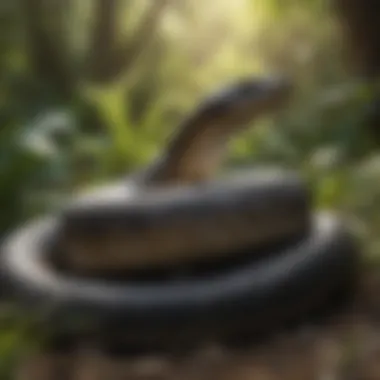
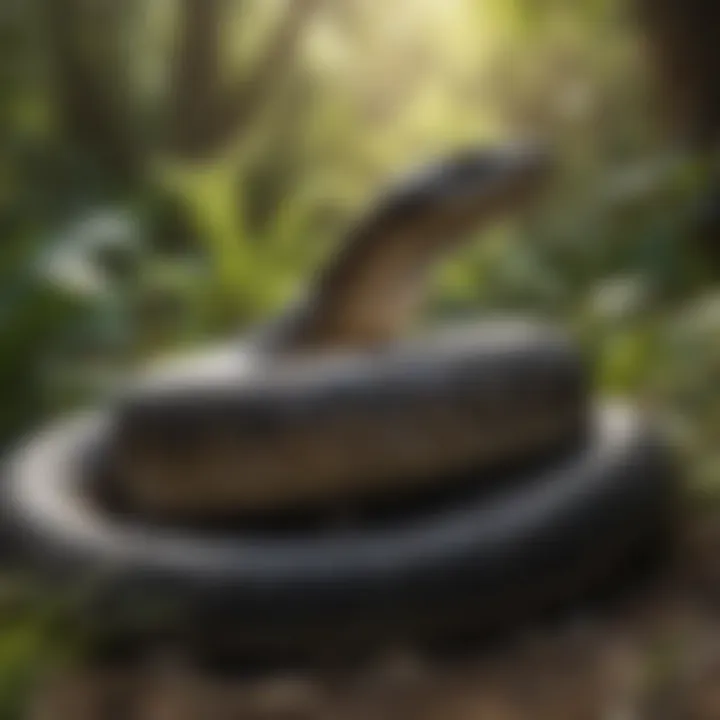
Intro
In gardens and yards, the presence of birds can be picturesque. However, certain species may become pests, damaging plants or stealing fruits. This situation leads many homeowners to seek effective methods for bird deterrence. One innovative method gaining traction is the use of snake decoys. This article explores the science behind how these decoys affect avian behavior. Furthermore, it discusses the placement and construction of these deterrents.
The objective is to understand how to effectively use snake decoys to manage bird populations. This approach may also support a more comprehensive strategy for long-term bird management.
Pest Identification
To effectively deter birds, first, it is crucial to identify which species are becoming problematic. Understanding the behavior and preferences of specific birds can inform better strategies. Common pest birds include:
- Starlings
- Sparrows
- Pigeons
- Crows
Signs and symptoms of infestations can include:
- Damage to plants, especially fruits and vegetables
- Nesting in unwanted areas such as attics or eaves
- Regular droppings in specific locations, indicating high activity
Recognizing these indicators will help in determining if snake decoys may be a suitable solution.
Understanding Bird Behavior
Birds often assess threats based on visual cues. A snake decoy simulates a predator, invoking a natural fear response. Birds are wary of snakes, which are common threats in their environment. This instinctual behavior can discourage their presence in treated areas.
When implementing this solution, consider the following:
- The type of snake decoy chosen: realistic designs are generally more effective.
- Location of placement: areas where birds frequent the most should be prioritized.
Implementation of Snake Decoys
Successful use of snake decoys involves more than just placement. Here are steps to ensure maximum effectiveness:
- Select the right type of decoy, such as those designed to mimic common snakes in the area.
- Strategically place decoys in visible locations. Near nesting sites or feeding areas tends to work best.
- Regularly relocate the decoys. Moving them occasionally keeps birds from becoming accustomed and ultimately disregarding them.
The focus should not solely be on aesthetics but on realism and practicality.
Complementary Strategies
While snake decoys can be effective, they often work best in conjunction with other strategies. Consider these options:
- Netting: In addition to decoys, using bird netting can prevent access to certain plants.
- Sound deterrents: Noise devices can be employed to create an unpleasant environment for birds.
Combining strategies ensures a comprehensive approach that enhances overall effectiveness.
"Preventing the presence of problematic birds often requires a multifaceted approach to achieve desirable results."
Epilogue
Using snake decoys offers a viable option for managing nuisance birds. By understanding avian behavior and effectively implementing decoys, homeowners can significantly reduce bird interference. It is important to remain aware of the specific bird species present and adjust strategies accordingly for the best outcome.
Preamble to Snake Decoys
Snake decoys serve as an intriguing solution for homeowners confronted with avian nuisance. Understanding their functionality can significantly aid in effective bird management. This section focuses on the importance of snake decoys, outlining their roles in deterring birds, the benefits they offer, and key considerations to keep in mind when using them.
Definition and Purpose
Snake decoys are artificial representations of snakes and are primarily intended to ward off birds from specific areas. The primary purpose lies in leveraging the natural fear birds have of snakes, which are known predators. By placing these decoys strategically, homeowners can create a visual deterrent that discourages birds from nesting or feeding in that area.
The effectiveness of snake decoys relies on basic principles of animal behavior. Birds often rely on visual cues to assess danger. Thus, even a non-living imitation of a snake can trigger an instinctive response, leading birds to perceive the area as unsafe. In practice, this means that snake decoys can reduce bird activity, which may ultimately protect gardens, crops, and property.
Historical Context
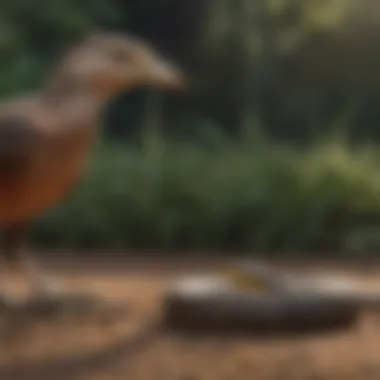
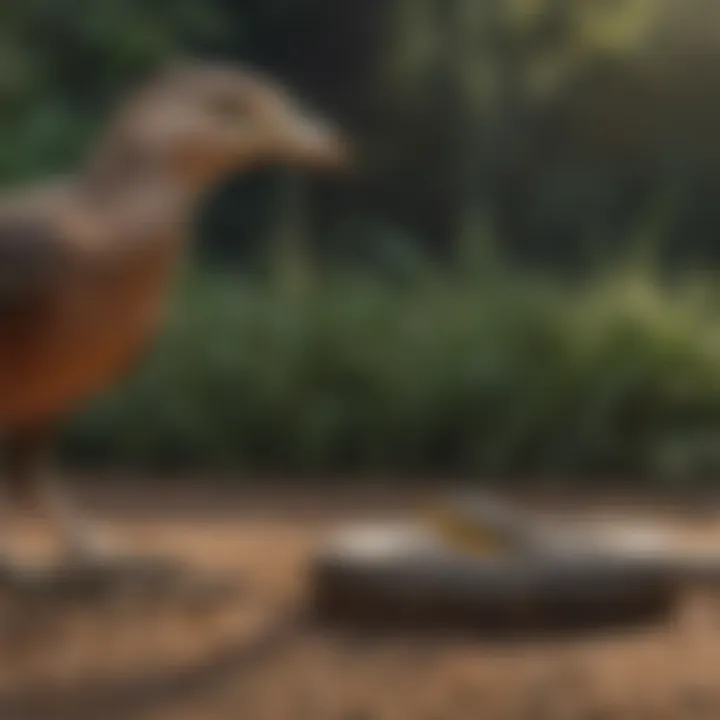
The use of decoys for pest control is not a novel idea; it has been practiced for decades. Early methods included the use of various objects like scarecrows to deter unwanted species. However, the focus specifically on snake decoys emerged over time as people recognized the effectiveness of more precise mimicry.
Historically, cultures across the globe have employed various forms of intimidation in agriculture and habitation. Utilizing realistic snake decoys can be traced back to rural communities where birds posed significant threats to crops. As these communities identified the reptilian threat as a primary predator, they began crafting models to enhance their protective strategies.
In modern times, the design of snake decoys has evolved. Technological advancements allow for the creation of decoys that closely resemble real snakes, enhancing their effectiveness. Additionally, insights from behavioral studies have informed how and where to position these decoys for optimal results.
Thus, the historical progression from rudimentary deterrents to sophisticated snake replicas highlights the growing understanding of avian behavior and the need for effective bird management solutions.
The Science of Bird Behavior
Understanding bird behavior is fundamental to grasping how snake decoys can effectively deter avian species from specific areas. Birds are inherently instinctual creatures, relying heavily on their perception of threats in their environment. Knowledge of these behaviors allows homeowners and pest control professionals to leverage snake decoys effectively. By mimicking the appearance of a snake, these decoys exploit the natural fear that many bird species have towards potential predators, thereby providing a mechanism for deterrence.
Understanding Threat Perception
Birds possess a well-developed system for detecting threats. This ability is critical for their survival. Their eyesight is highly acute, allowing them to notice changes in their surroundings with precision. When a bird observes a snake, real or decoy, it often triggers an instinctual reaction. This reaction may include flight to escape or avoidance behaviors to prevent proximity to the perceived threat.
For homeowners, the implications are significant. By positioning snake decoys in strategic locations, they can create a visual signal that warns birds of danger. This can reduce nesting sites in gardens or backyards, helping to maintain the desired aesthetic and function of outdoor spaces.
Species-Specific Responses to Predation Threats
Different bird species exhibit varying responses to predation threats. Some birds, such as sparrows and finches, may demonstrate a cautious approach when they recognize snakes. Others, like larger birds, might display more assertive behaviors, such as posturing or vocalizing warnings to fellow birds.
This diversity in reaction underscores the importance of understanding the specific species in one's region. It also raises the effectiveness of using snake decoys. For instance, a decoy that deters smaller birds may not have the same effect on larger birds. As a result, homeowners can benefit from researching the local avian population and their particular behaviors regarding threats. An efficient deterrence strategy requires not only the correct placement of snake decoys but also an understanding of the specific species one aims to deter.
In summary, the science of bird behavior is pivotal when implementing snake decoys for bird deterrence. Recognizing how birds perceive threats can empower individuals to make informed decisions regarding the placement and type of decoys used.
How Snake Decoys Work
Understanding how snake decoys work is essential in grasping their effectiveness for bird deterrence. This section explores the principles behind their operation, why they are successful at influencing avian behavior, and what makes their use beneficial in pest management strategies.
Mechanisms of Deterrence
The primary mechanism of snake decoys involves imitating the presence of a predator. Birds are instinctively programmed to respond to the sight of potential threats. When a snake decoy is introduced into an area, it triggers innate fear responses among various bird species. The visual cues of the decoy, including its size, shape, and color, can create the illusion of a snake lurking nearby.
This reaction is grounded in avian survival instinct. Birds recognize snakes as a significant threat, particularly in nesting or feeding environments. When they perceive these visual cues, their behavior can change dramatically. For example, they may avoid the area altogether, alter their foraging habits, or stay vigilant for longer periods. The decoy effectively disrupts their normal activity, reducing potential damage to property or crops.
Both realistic models and inflatable versions of snake decoys can be effective, but their effectiveness hinges on specific attributes such as lifelike design and strategic placement. The realism and position of the decoy can enhance its perceived threat level. In essence, by mimicking a predator effectively, snake decoys serve as psychological deterrents rather than actual physical threats.
Factors Affecting Effectiveness
The effectiveness of snake decoys can vary based on several crucial factors. These factors must be carefully considered for optimal results in deterring birds.
- Decoy Design: The level of realism in a snake decoy plays a critical role. Models that closely resemble actual snakes, both in appearance and movement, are more effective. A well-painted, lifelike decoy stands a greater chance of success.
- Placement Location: Strategic placement of snake decoys can significantly impact their effectiveness. Ideally, they should be positioned in areas where birds frequently gather or feed. Visual barriers or hiding spots nearby can enhance the decoy's impact.
- Environmental Conditions: Changes in the environment, such as movement from wind or other animals, can also affect how birds perceive the snake decoy. A static decoy may become less convincing if it fails to respond to environmental cues.
- Species-Specific Responses: Different bird species react distinctively to perceived threats. Some may be highly sensitive to the presence of snake decoys, while others might be less influenced. Therefore, understanding the specific birds in the area is critical.
- Duration of Use: Constant exposure to snake decoys may lead birds to become desensitized to the threat. Regularly relocating decoys or introducing new ones can help maintain their deterrent effect.
"Snake decoys serve as psychological deterrents, rather than physical threats, providing a unique approach to managing bird populations."
Types of Snake Decoys Available
Understanding the varieties of snake decoys is essential for anyone looking to effectively deter birds from their property. Different types of decoys have unique characteristics, and knowing these can help homeowners make informed decisions. This section delves into the two major categories of snake decoys: realistic models and inflatable versus static decoys. Both categories have distinct advantages and disadvantages and it is important to weigh these when considering the use of snake decoys.
Realistic Models
Realistic snake decoys are designed to closely mimic the appearance of actual snakes. They are often made from materials like plastic or rubber, engineered to provide lifelike detail. This attention to realism is crucial, as many species of birds are less likely to approach environments that appear to contain real threats. The realistic texture and colors of these models can enhance their effectiveness, which increases the chances of psychological deterrence.
When selecting a realistic snake model, considerations such as size and design should be taken into account. Snake decoys that resemble venomous species tend to be more effective in scare tactics. For instance, a model designed to look like a rattlesnake may evoke a larger fear response than a non-venomous species decoy.
Some well-regarded brands produce quality models that withstand various weather conditions, ensuring long-lasting use. Homeowners are often advised to place these models in visible areas where birds are likely to frequent. By doing so, it maximizes the decoy's visibility, enhancing its deterrent capabilities.
Inflatable vs. Static Decoys
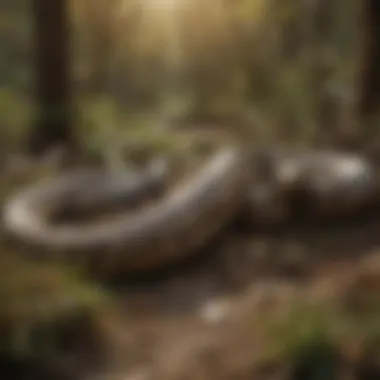

The market offers two main types of snake decoys: inflatable and static. Each has its own set of pros and cons.
- Inflatable Decoys: These decoys are usually quick to set up and can be easily transported. Being lighter and portable, they can be moved with ease, allowing homeowners to alter their positions based on seasonal changes in bird behavior. However, their effectiveness can be compromised by weather conditions such as strong winds or rain, which may hamper their stability.
- Static Decoys: Static models are more durable and robust. They can withstand harsh weather and do not require constant adjustments. The downside, however, is that they are generally fixed in one position, which may eventually reduce their effectiveness if birds become accustomed to their presence.
Important Consideration: Decoys need to be positioned strategically. Whether inflatable or static, placing snake decoys in high-traffic bird areas enhances their deterrent effect.
In sum, the choice between inflatable and static snake decoys depends largely on specific needs and preferences. Homeowners should weigh these considerations carefully to ensure effective bird management on their properties.
Creating an Effective Setup
Creating an effective setup for snake decoys is crucial for achieving optimal results in bird deterrence. This section discusses the specific elements that contribute to an effective arrangement, the benefits of strategic placement, and considerations homeowners should keep in mind. A successful setup can enhance the visibility of decoys, increase their realism, and ultimately improve their ability to deter birds.
Decoy Placement Strategies
Effective placement of snake decoys plays a significant role in their success. To begin with, homeowners should identify high-traffic areas where birds frequently feed, perch, or nest. This might include gardens, balconies, and rooftops. Strategically placing decoys in these areas maximizes the likelihood of encountering birds.
Additionally, the height and angle of decoys are essential. Installing them at bird-eye level allows for easier visibility. Consider using multiple decoys to create a more convincing presence. Bulky decoys should be nested among plants or backed by hard surfaces to mimic natural environments. The inclusion of natural elements, such as stones or wood, can enhance the illusion.
Another effective strategy is to periodically reposition the decoys. Birds may become accustomed to a fixed position. By changing the location or angle of the decoys, homeowners maintain an element of surprise, helping to sustain their deterrent effect.
Overcoming Limitations of Snake Decoys
Despite their advantages, snake decoys have certain limitations. It's essential to acknowledge these to fully leverage their potential. One primary limitation is that bird species may become desensitized over time. Thus, relying solely on snake decoys can lead to reduced effectiveness.
To combat this issue, it is advisable to mix deterrence methods. Homeowners can consider utilizing physical barriers such as netting or fencing alongside decoys. Integrating sound deterrents like bird alarms may also augment the effects of visual deterrents. The combination of visual and auditory stimuli creates a more intimidating environment for birds.
Furthermore, seasonal changes can affect bird behavior. For example, migratory patterns can influence which species are present during certain times of the year. Regular assessments of bird movements can provide insights for adjusting decoy strategies.
For best results, the integration of different deterrent strategies is key.
Complementary Bird Management Techniques
In the pursuit of effective bird deterrence, it is essential to integrate complementary bird management techniques alongside snake decoys. While snake decoys serve as a valuable tool in dissuading avian presence, their efficacy can be significantly enhanced when combined with other management strategies. This multi-faceted approach not only maximizes the potential to keep unwanted birds at bay but also fosters a more sustainable environment for homeowners and their properties.
Physical Barriers
Physical barriers are a reliable method for preventing birds from accessing specific areas. Structures like netting, mesh, or fencing can create an impediment that discourages birds from nesting or foraging where they are not wanted. Key benefits of physical barriers include:
- Durability: Strong materials can withstand harsh weather conditions and provide long-term protection.
- Accessibility Control: Barriers can be specifically designed to limit entry into gardens, attics, or other targeted zones.
- Non-Toxic: Unlike chemical deterrents, physical barriers do not pose any health risks to pets or children.
When implementing physical barriers, it is crucial to choose the appropriate materials and designs. For example, using netting with small enough holes can prevent smaller birds from getting through, while a sturdy fence can keep larger birds at bay. Installation should be consistent and checked regularly for any weaknesses that could compromise their integrity.
Sound Deterrents
Sound deterrents represent another layer of protection against birds. These devices produce noises that mimic predators or other unsettling sounds intended to scare birds away. They can be effective in altering bird behavior due to their instinctual responses to danger. Considerations for sound deterrents include:
- Variety of Sounds: Mixing sounds can prevent birds from becoming habituated to a single noise, maintaining their effectiveness.
- Timing and Volume Control: Proper scheduling for sound activation can optimize results, as well as adjusting the volume based on the surrounding environment.
- Humane Approach: Sound deterrents are generally non-invasive and do not harm birds, adhering to ethical guidelines in bird management.
When applying sound deterrents, it may be beneficial to position them near areas where birds are commonly seen or heard. Regular observation is necessary to gauge their effectiveness and adjust parameters as needed.
"Combining snake decoys with physical barriers and sound deterrents may greatly enhance bird management efforts, ensuring a more holistic solution."
Evaluating the Success of Snake Decoys
Evaluating the success of snake decoys is crucial in understanding their practical effectiveness in deterring birds. Homeowners and pest control professionals need to gauge whether these methods yield the desired results. Without this assessment, one cannot determine if the investment in snake decoys is justified or if alternative strategies should be considered. The importance of this evaluation lies in its ability to provide feedback and insights into the effectiveness of chosen deterrent methods, ensuring that efforts are directed toward solutions that genuinely work in specific environments.
Monitoring Bird Activity
Monitoring bird activity is a foundational step in evaluating the success of snake decoys. This involves observing bird behavior in relation to the presence of the decoys over time. Key points to consider include:
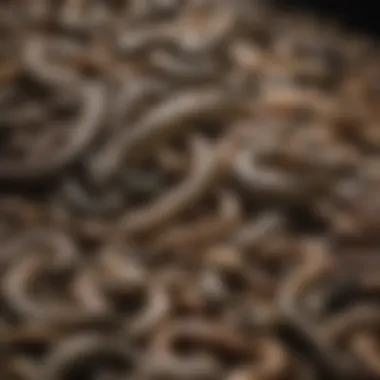
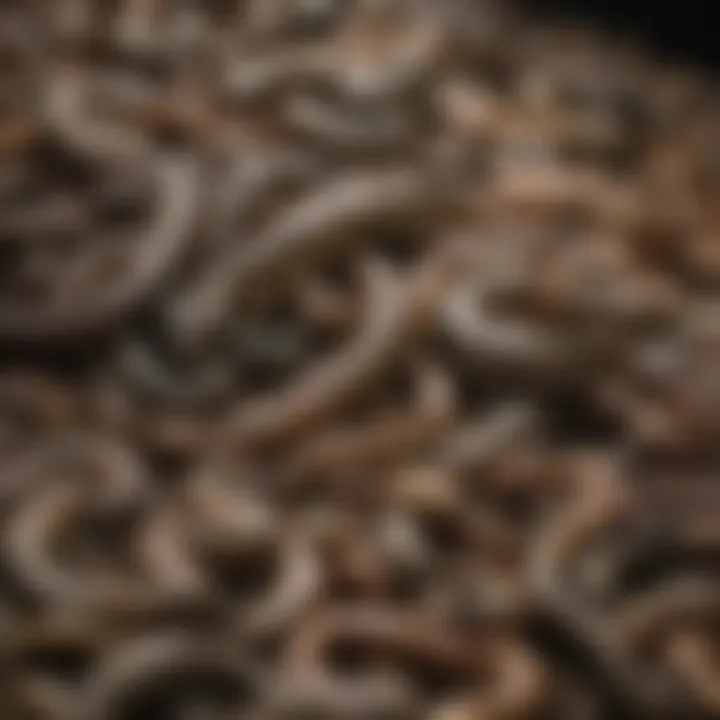
- Frequency of Bird Visits: Track how often birds visit the area before and after installation of the decoy. If there is a marked decrease in visits, that suggests effectiveness.
- Species Identification: Understand which bird species are present and their typical patterns. Some birds may be more affected by the sight of a snake decoy than others. Keeping detailed records about specific species interactions with the decoy can guide future decisions.
- Activity Times: Observe at what times birds are most active. This intelligence can influence when and how the decoys are deployed.
Utilizing tools like bird watching logs or apps can simplify this tracking process. Photos and timestamps can serve as evidence of changes in bird activity.
Adjusting Strategies Based on Observations
After monitoring bird activity, it becomes essential to adjust strategies based on observations. Here are important aspects to consider:
- Placement Changes: If birds appear to ignore the decoy, consider relocating it. New placements might be more effective in simulating a threat more realistically.
- Decoy Upgrades: Keep in mind that not all snake decoys are created equal. If one type is ineffective, exploring different styles, such as more realistic models or those that move, may yield better results.
- Seasonal Adjustments: Bird behavior can change throughout the year. This means adjustments may be needed based on seasonal migrations and breeding patterns. Regular evaluations throughout the year will help in optimizing the setup.
"Continual evaluation of bird deterrent strategies, including snake decoys, is vital in adapting to dynamic wildlife behavior."
By implementing a responsive approach, homeowners can better manage their bird populations and reduce the need for more drastic measures. Ultimately, evaluating the success of snake decoys is not a one-time task; it's an ongoing process that fosters effective bird management.
Case Studies and Anecdotal Evidence
Understanding real-world applications of snake decoys is crucial. Case studies and anecdotal evidence provide context that theoretical discussions might lack. They illustrate how these deterrents function in various environments and against specific bird species. This section will highlight successful implementations, as well as important lessons from failures. Such insights can be invaluable for homeowners and pest control professionals alike.
Successful Implementations
Successful uses of snake decoys showcase their potential effectiveness in deterring birds. For instance, a local orchard in California employed realistic snake decoys to protect their fruit from birds like the American robin. Placing the decoys near the fruit trees led to decreased bird visits. According to the orchard manager, the deterring effect was evident within a few days. This case highlights how the right placement and realistic design can yield positive results.
Another example comes from residential areas. Homeowners have reported that using static snake decoys in gardens significantly reduced the presence of unwanted birds, especially sparrows. By positioning these decoys on fences or within flower beds, they created a perception of danger. Homeowners noted a quick decline in bird activity, suggesting the psychological impact of the decoys was well translated.
Key factors in these successful cases include:
- Realism of the decoys: Models that closely mimic real snakes were essential.
- Strategic placement: Positioning decoys in visible areas proved critical for efficacy.
- Environmental considerations: Understanding local bird behavior influenced setup success.
"The sight of a snake can alter a bird's behavior immediately, leading to a safer environment for crops and gardens."
Lessons Learned from Failures
Not all implementations of snake decoys are successful. Understanding failures provides crucial learning moments. One common issue arises from the lack of realism in the decoys. For example, a bird sanctuary attempted to use inflatable snake models but noticed little change in bird activity. The birds remained unperturbed, indicating that the decoys failed to create a genuine perception of threat.
Additionally, improper placement can lead to ineffectiveness. Homeowners who placed decoys in areas where birds frequently roosted often observed no changes. Some reported that without careful strategic placement, birds became accustomed to the decoys and resumed their activities.
Challenges included:
- Poorly designed decoys: Models lacking detail or dimension did not deter birds effectively.
- Inconsistent monitoring: Failure to adjust placement based on bird activity meant many decoys became static.
- Mismatch with local species: Different bird species respond to threats differently; understanding this is essential.
In summary, case studies and anecdotal evidence play a pivotal role in understanding how snake decoys can function as deterrents. Learning from both successes and failures allows for better strategies and implementations, benefiting both homeowners and pest control professionals.
End
Understanding the application and efficacy of snake decoys in deterring birds presents several key elements worth noting. Firstly, these decoys serve as a visible threat to various bird species, which can successfully alter their behavior, reducing the chances of them returning to favored feeding or nesting areas. This simple yet effective strategy can be very beneficial for homeowners and professionals facing bird-related issues.
Additionally, the successful use of snake decoys relies heavily on their realistic appearance and appropriate placement, which enhances their aversive impact. Several studies indicate that the more lifelike the decoy, the better it tends to perform in real-world scenarios. Hence, it is important to consider both aesthetics and strategy when selecting a snake decoy product.
Finally, understanding bird behavior is essential for maximizing the effectiveness of any deterrent methods, including snake decoys. Each species has unique responses to threats, and recognizing these differences can lead to improved decision-making and better overall outcomes in bird management efforts.
It is crucial to evaluate not only the initial effectiveness of the deterrents but also their impact over time.
In summary, the integration of snake decoys in broader bird management strategies can yield significant benefits if applied thoughtfully and strategically. The benefits extend beyond immediate deterrence, fostering a sustainable relationship between homeowners and their avian environment.
Summarizing Key Points
- Effectiveness of Deterrents: Snake decoys can effectively deter birds, influencing their feeding and nesting behaviors.
- Importance of Realism: Realistic designs prove more effective at convincing birds of danger.
- Behavioral Insights: Awareness of specific species' behavior enhances the strategic use of decoys.
- Long-Term Evaluation: Continual assessment of effectiveness is essential for ongoing management.
Future Considerations for Bird Deterrence
Looking forward, several avenues can be explored to enhance bird deterrence efforts.
- Research and Development: Further research on more sophisticated decoy designs and materials could yield innovative products that better mimic natural predators.
- Integration with Technology: Exploring the use of technology such as motion sensors or cameras to monitor bird activity around decoys might provide valuable data for ongoing adjustments.
- Public Awareness and Education: Increasing public knowledge about bird behavior and effective deterrence methods could strengthen community efforts to manage bird populations.
- Holistic Strategies: Combining snake decoys with other methods, such as sound deterrents or physical barriers, provides a more comprehensive approach to bird management.
Ultimately, improvements in owl management science and engagement with real-world applications can lead to better outcomes for both birds and homeowners.



